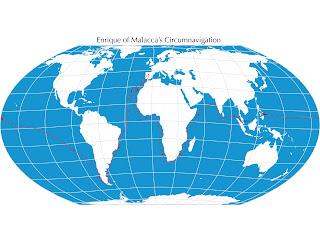 |
| The Contarini-Rosselli world map (1506). |
The Contarini-Rosselli map, engraved in copper in 1506, was one of the first to show the New World. It was designed by Giovanni Matteo Contarini and engraved by Francesco Rosselli. Their names and the date are indicated in Latin on the map next to the Cape of Good Hope. The map is a fan-shaped, coniform projection. It was discovered in 1922 and is currently housed at the British Library.
A Handful of Early World Maps
 |
| Contarini-Rosselli map, Africa. |
The Contarini-Rosselli map shows Africa with a high degree of accuracy, reflecting seven decades of Portuguese exploration along its west coast and a decade along the east coast after Bartolomeu Dias rounded the Cape of Good Hope in 1488. The interior of the continent, however, is speculation. Europeans still believed somewhere around modern-day Ethiopia lay the legendary kingdom of Prester John, a wealthy Christian king whom Europeans believed would help them defeat Islam.

Contarini-Rosselli map, India.
Eastern Limits: Arabia and India

Moving east, it is the heart of Islam, the Arabian Peninsula, where their knowledge broke down. Medieval Europeans had solid knowledge of the Red Sea, as shown in its shape on the Contarini-Rosselli map, yet across the peninsula, the Persian Gulf is given a similar size and silhouette as the Black Sea not far to the north.
In 1506, Portugal’s colonization effort was just getting underway. The year before, Francisco de Almeida departed Lisbon leading a fleet of 21 ships and 1,500 men, among them merchants, shoemakers, carpenters, priests, barbers, judges, and physicians—the various professions needed to staff colonial outposts. One of the fidalgos (nobles) sailing in that fleet was Ferdinand Magellan. It would not be until 1509 that the Portuguese (and Magellan) would first reach Malacca.
The Contarini-Rosselli map shows only fragments of India, though for the first time India is a peninsula of sorts. Listed are Calicut and other cities reached by Vasco da Gama and Pedro Álvares Cabral.
Western Limits: Cuba Meets Japan
In this island of Hispaniola I have taken possession of a large town which is most conveniently situated for the goldfields and for communication with the mainland both here, and there in the territory of the Grand Khan, with which there will be very profitable trade …
I should like to forbid this and let no one take any cotton except at my command then if there were any quantity I would order it all to be taken for your Majesty's your grocer on this island but only true the shortage of time I can give no exact account of it and here too the gold is found that they were hanging around their noses but in order not to waste time I wish to go and see if I can strike the island of Chipangu [Japan].
The land stretching into the North Atlantic from the top is marked as the province of Tangut, mentioned by Marco Polo.
By John Sailors
EnriqueofMalacca.com.
Images:
Francesco Rosselli, Public domain, via Wikimedia Commons. Cutouts by Enrique's Voyage.
(C) 2022, by John Sailors.
Maps
• The Fra Mauro Map
• The Cantino Planisphere
• Who was Enrique of Malacca? (History/Biography)
• What was Enrique of Malacca’s Real Name
• What was Enrique of Malacca’s Cause of Death?
• Was Enrique First to Circumnavigate the Earth?
• Where was Enrique of Malacca from?
• Was Enrique of Malacca Filipino?
- EnriqueOfMalacca.com
- Enrique of Malacca on Twitter
- Enrique of Malacca on Facebook
- John Sailors / Enrique on Medium
- And, yes, Enrique might be 500 years old, but he was known as a kid, so of course he's now on Instagram too.


